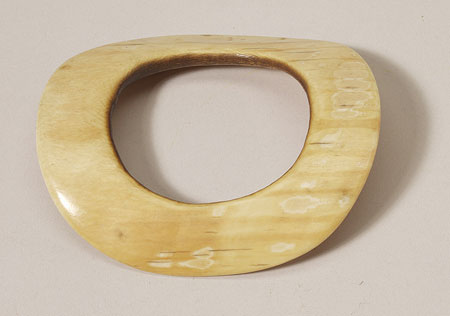Accession Number:
1917.25.78
Country:
Sudan
Region:
[Southern Sudan?] [White Nile]
Cultural Group:
Dinka
Date Made:
By 1917
Materials:
Elephant Tooth Ivory Animal
Process:
Carved , Polished
Dimensions:
L across outer edges = 121.3 mm, W = 106.3 mm, Th = 6.5 mm; inside hole measures 69.4 by 66 mm [RTS 1/6/2004].
Weight:
76.1 g
Other Owners:
Robert Grenville Gayer-Anderson, probably collected in the period immediately before World War I (1909-1914) [RTS 1/6/2004].
Field Collector:
Robert Grenville Gayer-Anderson
PRM Source:
Robert Grenville Gayer-Anderson
Acquired:
Donated 1917
Collected Date:
By 1917
Description:
Annular arm ornament, carved from a single piece of ivory into a narrow ring with oval plan view and a sub-rectangular section.
The upper surface is convex, with the body sloping down towards the outer edge; the underside is concave.
The surfaces have been polished.
The inside edge is stained a dark brown, and the underside has been partially discoloured a lighter brown around this.
The armlet is complete and intact, but has a number of cracks developing across its surface.
The upper surface has a series of white patches that may represent areas where the surface has worn away.
Otherwise the ivory is a creamy yellow colour (Pantone 7403C).
The armlet measures 121.3 by 106.3 across its outer edges, and 69.4 by 66 mm across its inside edges, with a thickness of 6.5 mm and a weight of 76.1 grams.
Collected by Robert Grenville Gayer-Anderson, probably between 1909 and 1914, in the period immediately before World War I, somewhere in the ‘White Nile’ region.
This object is said to be made from elephant ivory. For similar arm ornaments, see 1952.5.77 (Dinka) and 1917.25.82 (tribe not given). Domville Fife suggested that ivory bangles were worn by Dinka men who had speared an elephant (C.W. Domville Fife, 1927, Savage Life in the Black Sudan, p. 129); he does not give any specifics as to the actual form of the armlet, but gives it the name afjok . This is probably the term that appears in Nebel as apiok , meaning an ivory armlet. An alternative term is given as atum (ivory, round) (Nebel 1979, Dinka-English Dictionary, p. 106).
Currently on display in the Upper Gallery, Case 26A.
Rachael Sparks 17/9/2005.
Collected by Robert Grenville Gayer-Anderson, probably between 1909 and 1914, in the period immediately before World War I, somewhere in the ‘White Nile’ region.
This object is said to be made from elephant ivory. For similar arm ornaments, see 1952.5.77 (Dinka) and 1917.25.82 (tribe not given). Domville Fife suggested that ivory bangles were worn by Dinka men who had speared an elephant (C.W. Domville Fife, 1927, Savage Life in the Black Sudan, p. 129); he does not give any specifics as to the actual form of the armlet, but gives it the name afjok . This is probably the term that appears in Nebel as apiok , meaning an ivory armlet. An alternative term is given as atum (ivory, round) (Nebel 1979, Dinka-English Dictionary, p. 106).
Currently on display in the Upper Gallery, Case 26A.
Rachael Sparks 17/9/2005.
Primary Documentation:
Accession Book Entry
[VI, p.
54] - 1917 [pencil insert] 25 [end insert]
MAJOR R.G.
GAYER-ANDERSON
, R.A.M.C.
The Lodge, Old Marston, Oxon [pencil insert, p.
56] 77-82 [end insert] - [1 of] 6 Dinka armlets of elephant ivory, White Nile.
Additional Accession Book Entry [page opposite 54] - A gift to the Pitt Rivers Museum in memory of Major R.G. Gayer-Anderson, Pasha, his twin brother Colonel J.G. Gayer-Anderson, C.M.G., D.S.O. [page opposite 56] 1917.25.77-80 Nos given AP [red biro] A20 F10 21.
Card Catalogue Entry - The catalogue card repeats the accession book entry, as a group for the six armlets, but is annotated with three negative numbers: A20.F10.15, A20.F10.21 and A20.F10.23. It is not clear which number belongs with which object [RTS 9/3/2004].
Related Documents File - Two letters dated 30/03/1917 and 13/04/1917 from the donor to Henry Balfour regarding the donation of the collection to the museum [EB 12/11/2001]. These indicate that the material was collected by Robert Gayer-Anderson himself, chiefly from the areas of Nuba, Kordofan and Bahr el Ghazal during 5 years he spent in the Sudan, and that they were given to the museum as an unconditional gift [RTS 5/12/2003]. The note in the accession book calling this gift 'in memory of' R.G. Gayer-Anderson is therefore somewhat enigmatic, as both Robert and his twin brother (Thomas G., not J.G.) were alive at the time of the transfer [RTS 5/12/2003].
Written on object - DINKA armlet, WHITE NILE. d.d. Major R.G. Gayer Anderson 1917.25.78 [RTS 1/6/2004].
Additional Accession Book Entry [page opposite 54] - A gift to the Pitt Rivers Museum in memory of Major R.G. Gayer-Anderson, Pasha, his twin brother Colonel J.G. Gayer-Anderson, C.M.G., D.S.O. [page opposite 56] 1917.25.77-80 Nos given AP [red biro] A20 F10 21.
Card Catalogue Entry - The catalogue card repeats the accession book entry, as a group for the six armlets, but is annotated with three negative numbers: A20.F10.15, A20.F10.21 and A20.F10.23. It is not clear which number belongs with which object [RTS 9/3/2004].
Related Documents File - Two letters dated 30/03/1917 and 13/04/1917 from the donor to Henry Balfour regarding the donation of the collection to the museum [EB 12/11/2001]. These indicate that the material was collected by Robert Gayer-Anderson himself, chiefly from the areas of Nuba, Kordofan and Bahr el Ghazal during 5 years he spent in the Sudan, and that they were given to the museum as an unconditional gift [RTS 5/12/2003]. The note in the accession book calling this gift 'in memory of' R.G. Gayer-Anderson is therefore somewhat enigmatic, as both Robert and his twin brother (Thomas G., not J.G.) were alive at the time of the transfer [RTS 5/12/2003].
Written on object - DINKA armlet, WHITE NILE. d.d. Major R.G. Gayer Anderson 1917.25.78 [RTS 1/6/2004].



